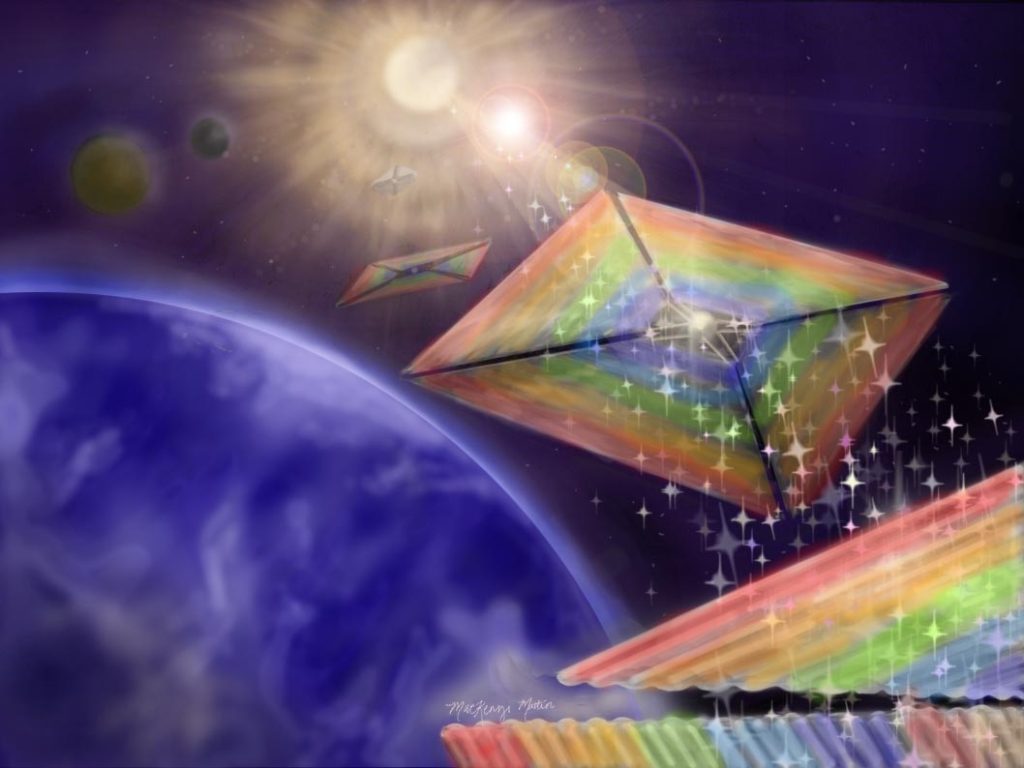
Dispersed solar sails, shown in this conceptual illustration, can enable missions to hard-to-reach places, such as orbits above the sun’s poles. Credit: Mackenzie Martin
Like[{” attribute=””>NASA’s exploration continues to push boundaries, a new solar sail concept has been selected by the agency for development toward a demonstration mission that could carry science to new destinations.
The Diffractive Solar Sailing project was selected for Phase III study under the NASA Innovative Advanced Concepts (NIAC) program. Phase III aims to strategically transition NIAC concepts with the greatest potential impact for NASA, other government agencies, or commercial partners.
“As we venture farther out into the cosmos than ever before, we’ll need innovative, cutting-edge technologies to drive our missions,” said NASA Administrator Bill Nelson. “The NASA Innovative Advanced Concepts program helps to unlock visionary ideas – like novel solar sails – and bring them closer to reality.”
Just like a sailboat using wind to cross the ocean, solar sails use the pressure exerted by sunlight to propel a craft through space. Existing reflective solar sail designs are usually very large and very thin, and they are limited by the direction of the sunlight, forcing tradeoffs between power and navigation. Diffractive lightsails would use small gratings embedded in thin films to take advantage of a property of light called diffraction, which causes light to spread out when it passes through a narrow opening. This would enable the spacecraft to make more efficient use of sunlight without sacrificing maneuverability.
“Exploring the universe means we need new instruments, new ideas, and new ways of going places,” said Jim Reuter, associate administrator for NASA’s Space Technology Mission Directorate (STMD) at NASA Headquarters in Washington. “Our goal is to invest in those technologies throughout their lifecycle to support a robust ecosystem of innovation.”
From human exploration of deep space to advanced propulsion and robotics, NASA’s Innovative Advanced Concepts (NIAC) aims to change the possible by supporting early-stage space technology research that could fundamentally change the future. credit: NASA
The NIAC Phase III award will award the research team $2 million over two years to further develop the technology in preparation for a potential future demonstration mission. The project is led by Amber Dobell of the Johns Hopkins University Applied Physics Laboratory in Laurel, Maryland.
“NIAC allows us to advance some of the most innovative technology concepts in aviation,” said Mike LaPointe, acting executive director of the NIAC Program at NASA Headquarters. “Our goal is to change the potential promises, and reflective solar sails to do just that for a number of exciting new mission applications.”
Reflective light sails would extend the capacity of a solar sail far beyond what is possible with the missions under development today. The project is led by Amber Dobell of the Johns Hopkins University Applied Physics Laboratory in Laurel, Maryland. The concept’s feasibility has been previously studied under NIAC’s Phase I and Phase II awards, led by Dr. Grover Schwazlander of Rochester Institute of Technology in New York, who continues to serve as co-investigator on the project. Les Johnson, who is leading two of NASA’s upcoming solar sail missions at NASA’s Marshall Space Flight Center in Huntsville, Alabama, is also an associate investigator. Under previous awards, the team has designed, created and tested various types of diffraction sail materials; Experiments conducted and new navigation and control schemes designed for a potential deflected optical sail mission around the sun’s poles.
Work under Phase III will improve sail material and conduct ground testing in support of this conceptual solar mission. Orbits over the sun’s north and south poles are difficult to achieve using conventional spacecraft propulsion. Driven by the constant pressure of the sun’s rays, the lightweight reflective spotlights could put a group of science spacecraft into orbit around the sun’s poles to advance our understanding of the sun and improve our space weather forecasting capabilities.
“Reflective solar sailing is a modern take on the decades-old view of photovoltaic lights. While this technology can improve many mission structures, it is poised to greatly impact the solar physics community’s need for unique solar-monitoring capabilities,” he said. Dobel. “With our team’s combined expertise in optics, space, conventional solar sailing, and metamaterials, we hope to allow scientists to see the sun like never before.”
The NIAC supports visionary research ideas through a multi-progressive Study stages. NASA announced 17 first stage and second stage Suggestion selections February 2022. NIAC is funded by NASA’s STMD, which is responsible for developing new comprehensive technologies and capabilities that the agency needs to achieve its current and future missions.

“Web maven. Infuriatingly humble beer geek. Bacon fanatic. Typical creator. Music expert.”





More Stories
NASA Close to Deciding What to Do With Boeing’s Troubled Starliner Spacecraft
Scientists May Have Discovered ‘Dark Oxygen’ Created Without Photosynthesis: NPR
Real Scientists Lived on Fake Mars in a Texas Shed for a Year